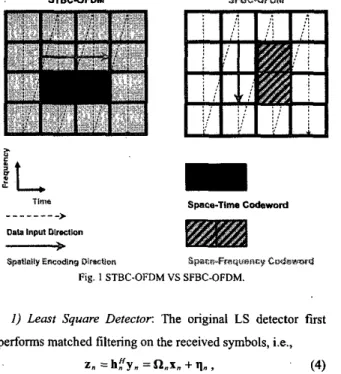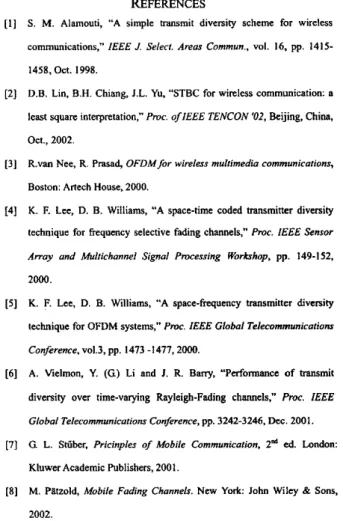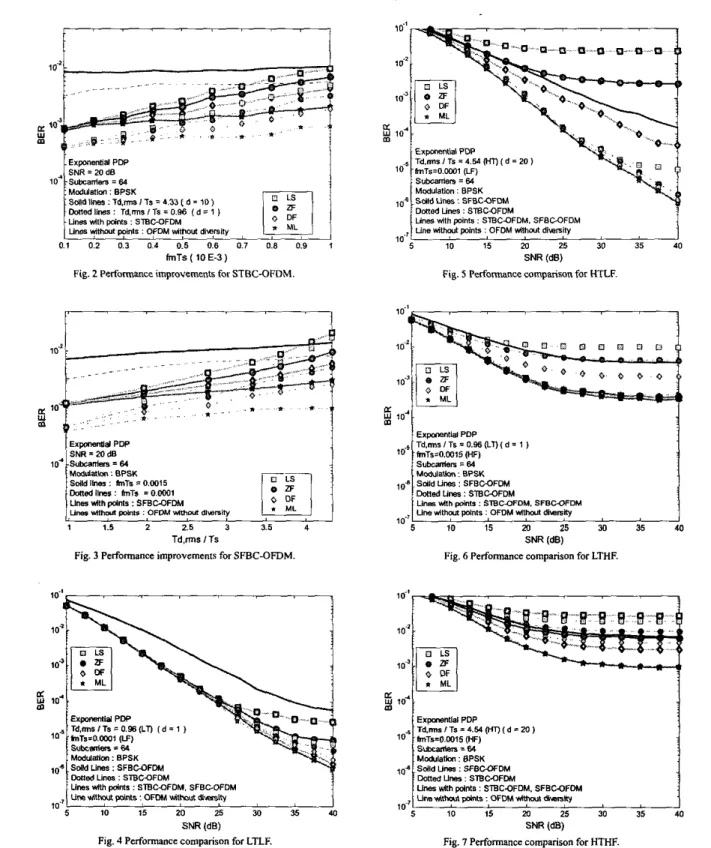Improved Transmit Diversity Block Coded OFDM
Systems for Highly Dispersive Channels
Bing-Hung Chiang I , Ding-Bing Linz, Hsueh-Jyh Li I , Jia-Li Wang2
I Graduate Institute
of
Communication Engineering, National Taiwan University, Taiwan, R.O.C., +886-2-2363525 1 Ext. 538, hjli@ew.ee.ntu.edu.twInstitute
of
Computer, Communication and Control, National Taipei Universityof
Technology, Taiwan, R.O.C.,2
+886-2-2771-2171 Ext. 2274, dblin@ntut.edu.tw
Absnofr-In 2000, King proposed two g, -based transmit diversity block coded OFDM (TDBC-OFDM) systems, i.e., space-time block coded OFDM (STBC-OFDM) and space- frequency block coded OFDM (SFBC-OFDM). However, he employed the least square (LS) detector, which was designed under the assumption that the channel is static over the duration of a space-timelfrequency codeword. Thereupon, S T B C - O F D W
SFBC-OFDM suffers from highly timdfrequency selectivity of
the channel. Recently, Antony recommended three novel detectors for space-time block coding (STBC) to combat the rapid channel variation. In our work, these detectors are applied to improve the original g, -based TDBC-OFDM systems. Also, the performances of the improved g, -based TDBC-OFDM
systems are evaluated by computer simulation. Simulation resultr have revealed that significant performance improvement can be achieved even when the systems are operated in highly dispersive channels.
I. INTRODUCTION
Space-time block coding (STBC) or transmit diversity block coding (TDBC), an effective transmit diversity technique, was first proposed by Alamouti [l] for flat fading channels. Based
on the assumption that the channel is static over the duration of a space-time codeword, it can obtain the same performance as maximum ratio combining (MRC) for receive diversity by
least square (LS) detection [2]. Orthogonal frequency division
multiplexing (OFDM) is an excellent technique that is capable of reducing the frequency-selective fading into frequency- nonselective or flat fading [3]. Thus TDBC can be used for
OFDM systems to improve the performance.
According to Alamouti code, g,
,
King proposed two combinations of TDBC and OFDM, i.e., space-time blockcoded OFDM (STBC-OFDM) [4] and space-frequency block coded OFDM (SFBC-OFDM) [ 5 ] . However, he employed the LS detector, which was designed under the assumption that the
channel is static over the duration of a space-timdfrequency codeword. Thereupon, STBC-OFDWSFBC-OFDM suffers from highly time/frequency-selectivity of the channel.
Recently, Antony recommended three novel detectors for space-time block coding (STBC) to combat the rapid channel variation. They are zero-forcing (ZF), decision-feedback (DF) and maximum-likelihood (ML) detectors [6].
In
this paper, instead of the originalLS
detector, these novel detectors are applied to improve the performances ofg, -based TDBC-OFDM systems. In addition, the performances of the improved g, -based TDBC-OFDM system are evaluated by computer simulation. Simulation results have revealed that significant performance improvement can be achieved even when the systems are operated in highly dispersive channels.
11. TRANSMIT DIVERSITY BLOCK CODED OFDM Notice that subsequent description about TDBC-OFDM is based on three assumptions: first, sufficient cyclic prefix (CP) is added to avoid inter-block interference (IBI); second, the channel is constant over one OFDM block duration; third, the channel estimation is perfect. As mentioned before, there are two types of g2 -based TDBC-OFDM, namely, STBC-OFDM and SFBC-OFDM. The comparison of these dual systems is shown in Fig. 1.
A. STBC-OFDM
For STBC-OFDM, two consecutive OFDM blocks,
X,,,,
and
X,.,,
, are transmitted from two transmit antennas in twoOFDM block durations. Hence, the equivalent STBC transmission matrix for g , is [4]
where
X*".?
=L*p,o
Ln,,'".*.*,.",.,P
f o r p = 1.2 . xln*p.* is the transmitted symbol for the kth subcarria in the (2ntp)th block, and N , is the number of subcarriers per OFDM block.In other words, at block instant (2rrtO),
X,,,,
andX,,,,
are transmitted kom antenna 1 and 2, respectively. Then, at block instant (2n+l),
-Xim+,
and X;n+o are transmitted from antenna 1 and 2 , respectively. Therefore, the system function for STBC-OFDM system can be expressed asymc
=%A"
+ wmcwhere
hj,2n+p,, is the channel frequency response from the ith transmit antenna to the receive antenna for the Rth subcarrier in the (2rrtp)th block.
H,.2"*p =diag[h,,>",p,o h,,,"*?,, " ' h,.*"*p,",.,l f o r i = l 2 '
For subcarrier
k,
the detectors consider a pair of symbols, namely, the nth space-lime codeword as follows.y.=h.x.+w,
[".+ti]
- - p ; z n + o . i hz,zn+o,k X20+0t (3)Yzn+i.i h2,2,+,,k -h[,.+~,k][x,"+,,,]+[
2::;:]
'it__
e
SpsUolly Encoding DIncUon S ~Cd".$ ~ ~ ~ ~ ~ ~ , ~ ~ ~
Fig. 1 STBC-OFDM VS SFBC-OFDM.
I ) Least Square Detector: The original LS detector first performs matched filtering on the received symbols, i.e.,
Z. = hHy, =
n,x.
+ q., (4)where 2. = [Gn+o.it Z 2 n + 1 . k r ,
'In = h f w n and
P
= h~,z~+o~hz,zn+o,~ -h;in+i.kh2.zn+i,k.
It is clear that
P
is the spatial inter-symbol infe$erence (ISI) resulting from rapid channel variation. Nevertheless, the LSdetector ignores this spatial IS1 and obtains the bad estimates
and
i,,,,,,
by performing hard-decision on z , ~ ~ ~ . ~ and independently.2) Zero-Forcing Detector: The novel ZF detector forces the
spatial IS1 to zero without the consideration ofnoise [6],'i.e., where z. = [z,n+,,k i, "+,. r a n d
i.
= hi'w..
in
= hi'y, = x.+ i n ,
( 5 )Apparently, the noise component,
in,
is correlated, but the ZF detector disregards the correlation and acquires the suboptimum estimates i,.,,,, and i,.+,,k by performing hard-decision on i,,+o,, and i2"+,,* separately.3) Decision-Feedback Defector: The novel DF detector benefits from the whitened-matched filtering output [ 6 ] , i.e.,
G , =
where x , z r * o =[x..o x,.z " x m , Z k + O . . x . . N s . z P .
for k = O , I , . . , (N,/Z-I).
x#.Zk+l = 6 ; m . I x n . 3 ~ ' x n , 2 k + 1 ' . x n . N , - I P 3
Therefore, at the first half of each OFDM block duration,
X,,k,, and X,,,,,I are transmitted from antenna I and 2, 0
lht,zn+o.khbn+i.k + h2.zn+a.kh;.zn+i.k
1
& . z n + l , k ) 2 + Ihz.zn+o.r12$ % 2 . + 1 , k 1 ~ + Ihz.zn+o.illz
-
hl.zn+o.th;.zn+o.k - h~.2n+l.kh;.zn+i,i J l h l , 2 n + , , k 1 2 + l h 2 , 2 n + 0 , k 1 2respectively. Then, at the second half of each OFDM block duration, -Xi,,,+, and X;,,k+o are transmitted from antenna 1 and 2, respectively. Consequently, the system function for SFBC-OFDM system is expressed as
YSFBC = H S F B C ~ S F B C + WSFK
[ " 2 * + 0 ] - [ " y ~ + o
-
H 2 , n . z ~x,,,,+o
Wn,2k+0y n . 2 k + l H,,n,zk+, - H ; . n , 2 k + l ] [ x n , Z k + ! ] + [ w c k + l ] ' (13) where H i . n . 2 k + ~ = diag[hi,.o hi.".2 ..h,,,2,+o
' 4 n , ~ , - ~ l ,
H,.,,,,+I = diag[h; ...I hj,",3 ..h,,,,2k+l - h r . n . ~ r - l l ,
for i = 1 2 and k = O , l , . . , ( N s / 2 - l ) .
For the nth block, the detectors consider a pair of symbols,
namely, the kth space-frequency codeword as follows. Y k =hixk + w k
P*+o]
- - [hl.,"+o h2.;2k+o ~ n , z i t + o (14)Y~.Z*+I h,,.,,,,, -h,,,,,+l][x.,.~+,]'[~::::P] '
Subsequently, the operations of the detectors for SFBC- OFDM are similar to that for STBC-OFDM.
111. CHANNEL MODEL
In this paper, the systems are assumed to be operated in the
WSSUS Rayleigh fading channel with exponentially decaying
power delay profile described as follows [7]. The fading power of the mth path is
U: = ~ ? e - " " ~ for m=1,2,..M, (15)
where M i s the number of paths. Note that dcontrols the delay spread and Cis chosen to satisfy the constraint
Then solving for C yields
It is clear that a small d indicates a small delay spread, and vice versus
For simplicity, the T,-spaced channel model is used here for the simulation of wideband multipath fading channel [7], where T, is the reciprocal of the system bandwidth. Furthermore, each of the uncorrelated taps is of U-shape
power spectral density and is generated by the mobile fading channel simulator independently [8].
Iv.
PERFORMANdE RESULTSFor all simulations, the parameters are as follows. Firstly, the number of uncorrelated paths is 16 and hence the duration of CP is 16T, seconds; secondly, the number of subcaniers is 64 and hence the total OFDM block duration SOT, seconds; thirdly, the system bandwidth is 20MHz; finally, the modulation is BPSK.
Fig. 2 and Fig. 3 are the simulation results for STBC- OFDM and SFBC-OFDM, respectively. As seen from the figures, all detectors obtain similar performances in smoothly dispersive channels, whereas the three novel detectors outperform LS detector significantly in highly dispersive channels. In addition, the error probabilities for ML detectors remain nearly constant with increasing fmT, (normalized Doppler frequency) for STBC-OFDM or with increasing Td,JT, (normalized delay spread) for SFBC-OFDM; indeed, one can conclude that ML detector is robust to channel selectivity. Furthermore, it is obvious that, with the aid of ML detectors, the error probabilities of TDBC-OFDM systems are much lower than that of conventional OFDM systems.
As shown in Fig. 4
-
Fig. 7, the performances of TDBC- OFDM systems are comparedin
four extremescenarios,
namely, LTLF, HTLF, LTHF and HTHF, respectively. For instant, LTHF stands for low time-dispersion (i.e. frequency- selectivity) and high frequencydispersion (i.e. time- selectivity). Since STBC-OFDM and SFBC-OFDM are sensitive to frequency-dispersion and timedispersion, respectively, they obtain similar performance for both LTLF (Fig. 4) and HTHF (Fig.
7).
Additionally, STBC-OFDM performs better than SFBC-OFDM for HTLF (Fig.9,
and vice versus (Fig. 6). Again, TDBC-OFDM system with ML detectors are always of the best performance as a result of considering the spatial IS1 and noise simultaneously.V. CONCLUSIONS
In this paper, three novel detectors are applied to TDBC-OFDM systems. To combat the spatial IS1 resulting
from high channel dispersion, ZF detectorjust force the spatial
IS1 to zero, DF detector alleviates the spatial IS1 by
whitened-matched filtering and ML detector reduces the spatial IS1 and noise simultaneously. Thereupon, ML detector
is of the best performance but highest complexity, while DF and ZF detectors are of poorer performance but less complexity. However, with the aid of these novel detectors, TDBC-OFDM system are now compatible with the requirements for wideband wireless applications in highly dispersive channels.
REFERENCES
[ I ] S. M. Alamouti, “A simple transmit diversity scheme for wirclcss communications,” IEEE J. Selerl. A r e a Commun., vol. 16, pp. 1415- 1458, Oct. 1998.
D.B. Lin, B.H. Chiang, I.L. Yu, “STBC for winless communication: a
least square interpretation,” Pmc. o/IEEE TENCON ’02, Beijing, China, [Z]
Oct., 2002.
[3] R.- Nee, R. P m d , OFDM/or wireierr mulfimedio communicafions,
Boston: AReeh House, ZWO.
K. E LCC, D. B. Williams, “A spcc-time coded transmitter diversity technique for frequency wleetive fading channels,” Pme. IEEE Sensor Amay and MuNichannel Signal Pmeming Worbhop, pp. 149-152, 2 w o .
K. E Lee, D. B. Williams, “A space-frequency transminer diversity
technique for OFDM systems,” P m , IEEE Global Telecommunicolionr
Confirenee. ~01.3, pp. 1473 -1477,2000.
A. Welmon, Y. (G) Li and 1. R. Barry, “Perfonnancc of “il
diversity over time-varying Rayleigh-Fading channcls,” h. IEEE
Global Telecommunicorionr Con/*ence, pp. 3242-3246, Lkc. 2001.
G L. SWXxr. Pricinple o/ Mobile Communicafion, 2d ed. London: Kluwer Academic Publishen, 2001.
M. Patzold, Mobile Fading Channels. Nnu York: Iohn Wilcy & Sons,
2002. [4] [ 5 ] 161 [7] (81 1176
Exp~entia PDP lo* 1 ML 0.1 0.2 0.3 0.4 0.5 0.6 0.7 0.8 0.9 1 SdldUner: S F B W F D M Ddld tinas : STBWFDM Unss wlfh a n t s : STBWFDM. S F B M F D U
U m wlmaut p M m : OFDM wlthaut a \ F d y fmTs(10E-3)
Fig. 2 P w k " improvements for STBC-OFDM.
i
pg
3.5 4
Td,rmsITs
Fig. 3 Performance improvements for SFBC-OFDM.
SNR (dB)
Fig. 4 Performance comparison for LTLR
Unes W h mints : STBCQFDM. SFBCOFDM
une wl& points : OFDM wllhout dhenify
5 10 15 20 25 30 35 40
SNR (d6)
Fig. 5 Perfomnce comparison for HTLF.
t
Exoanenll PDPi
SNR W)


